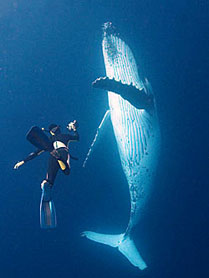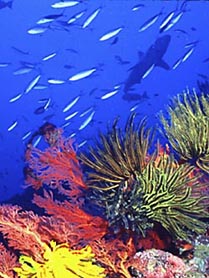Vinaka to all of the crew of the wonderful NAI'A! The
trip lived up to -- no, exceeded our expectations for our first diving
in the Pacific. From the quarters to the food to the crew to the diving,
everything was outstanding. Thanks for a wonderful trip!
- Vanuatu: Coolidge, Kastum, and Critters
- Channel Surfing in New Caledonia
- Phoenix Rises Again
- Marine Conservation in Fiji
- Humpback Whales
- Ahead
- NAI'A: The Next Generation
- All in the Family
- Vinaka Discount
NAI'A + the crew + the diving is an unbeatable
combination.
The Royal Flush of diving!
Judy & Dick Spann, Carlisle MA
I have wanderlust, I admit it. I built NAI'A as an expeditionary
ship to explore the best (warm!) diving on this planet, and although
we have found much of it right here in Fiji, we are always tempted
to look beyond the horizon. When Paul Humann told me five years ago
that he had enjoyed superior diving in Vanuatu, he planted a bug that
wouldn't go away. So in March 2000 we took NAI'A to Vanuatu for three
ten-day expeditions.
It was a grand adventure, even written up as a cover story for Undercurrent,
but events in the ugly outside world kept us away for a few years.
So this year we convened a stellar group of NAI'A passengers, some
on their fifth or sixth trip, for a return to Vanuatu. And since we
were going that far already, why not check out New Caledonia as well?
Vanuatu: Coolidge, Kastum, and Critters
Seventeen-year Vanuatu resident, Kevin Green, joined us once again as local guide, translator, and chief haggler. From the remote Banks Islands in the far north through the giant President Coolidge wreck and down to the cosmopolitan harbor of Port Vila, we enjoyed bat-filled sea caves, virtually unlimited visibility on rich, current-swept sea mounts, a muck dive at the base of a waterfall, and some of the best night dives any of us had ever done. Never mind the Spanish dancers, hunting lionfish, nudibranchs laying eggs, tent-feeding octopus, rampaging turtles, or the pair of small-pouch pygmy pipehorses ... it was the free-swimming nautilus in 15 ft. that most amazed me.
Vanuatu is a rough, wild and wooly place with spectacular vistas around every headland and unique people living in every valley. Twice we visited ashore to participate in special kastum dances. In one village the male dancers painted themselves to look like seasnakes while, in the other, village women performed an amazing percussion song by slapping the water surface for snare-drum effects and doing some mysterious underwater move that created a haunting base note. Absolutely incredible!
Channel Surfing in New Caledonia
The fish life is like it must have been in most
Tropical Pacific waters 50-60 years ago.... We saw 6-10 huge groupers
on every dive -- the size groupers you consider an exceptional find
elsewhere.
Paul Humann, Davie FL
For years cruising sailors have told me that the outlying islands in New Caledonia feature incredible fishing (although the fish are inedible due to ciguatera poisoning). But I'd never found a diver who has been there to confirm the tales. So our hardy Vanuatu adventurers, with a handful of substitutions, embarked on an expedition to dive were no one has dived before. Instead of starting near Noumea, where the diving is well-known and not particularly exciting, we concentrated on isolated reefs and shoals to the north and west of the main island. It was awesome.
After one of our first dives outside a raging channel through the Grande Recif de Cook, I came up alongside Paul Humann. Paul, who normally has a fine vocabulary, was reduced to a wide-eyed, "wow" and "wow" again. We had dropped in on a current-washed slope covered in sea fans, soft and hard corals, and so many different fish it was hard to know where to look. Corralling the vast schools of fish against the slope were white-tip, grey reef and silver-tip reef sharks. A turtle swam by and two huge Queensland grouper appeared at the top of the slope and surveyed us, apparently unable to decide whether they would tolerate us in their domain. When our hearts had finally slowed down and we were able to focus our attention a bit closer, we saw that the whole reef face was home to critters in an abundance we had seldom seen before.
On another dive at a very isolated reef sixty miles offshore, a lone minke whale came and spent the entire afternoon with us. And on virtually every dive we found small creatures much better known from Indonesia and P.N.G. such as watanabe angelfish, magenta-streaked wrasse, black butterflyfish, key-hole angelfish, harlequin tuskfish, juvenile barramundi, white-capped shrimp gobies, and one very tiny, very cute red frogfish.
Our ten days in New Caledonia flew by, particularly since the last two days spent making our way back to Noumea were relatively disappointing from a diving point of view. Would we go back? In a minute! The coral reefs are the closest I've ever seen to Fiji's and the fish life is nearly as profuse as in the Phoenix Islands. But New Caledonia is French and permission to operate there on a regular basis is currently impossible without a newly built French ship and French crew. But we made some excellent contacts there and a new government was recently elected that may permit us to visit again. If you would like to be included on our New Caledonia wish list, please send us an e-mail with "New Caledonia" in the subject box.
Phoenix Rises Again
Most of you who have dived with or followed NAI'A over the years know that we have been to the Phoenix Islands, a thousand miles north of Fiji, five times. Perhaps you saw the National Geographic or Skin Diver articles about our voyages. The Phoenix archipelago is truly one of the last pristine seascapes left in the world and our voyages there are called Primal Ocean Expeditions for good reason.
As a result of our expeditions, a very important conservation initiative is in the works to protect the isolated Phoenix Islands against commercial fishing pressure. In further support of that initiative, we are returning to the Phoenix Islands next May for thirteen dive days to recover data from our monitoring instruments and to further survey and record the status of the reefs there. The expedition will start and end in Samoa, which trims the total number of ocean passage days to seven, but it is still not for the weak-hearted. Any way you look at it, the Phoenix Islands are extremely isolated and, therefore, difficult and expensive to visit.
As this newsletter enters the internet ether the Primal Ocean Expedition 2005 is virtually sold out but there may be cancellations, so if you would like to join our waiting list, please send us an e-mail with "Phoenix Islands: in the subject box.
Marine Conservation in Fiji
We've seen the quality of our reefs rise and fall according to El Nino, La Nina, the intensity of summer storms, and many other factors that we can't identify. But recently we looked back at video from eleven years ago and we were surprised to see that some of the luxuriously rich reefs that we love so well now didn't look nearly as healthy a decade ago. The fact is: reefs change over time. One of the great advantages of a liveaboard is the ability to adjust to the changes.
Recent work by the Wildlife Conservation Society (www.nature.com/news/2004/040809/full/040809-8.html), with whom we are working to develop the Bligh/Lomaiviti Seascape Reserve, has shown that some symbiotic algae is better able than others to resist water temperature rises. Reefs that have suffered coral bleaching, but recovered, tend to have more of the "good algae" than do unaffected reefs, making them better source reefs in time of stress.
NAI'A's dive circuit includes several reef systems that either resisted or recovered well from the 2000 coral-bleaching episode, even while some other reefs in Fiji and elsewhere did not. These reefs are not only our current favorites, but are included in the Bligh/Lomaiviti Seascape Reserve, plans for which are progressing well. After a WWF-sponsored conference last year identified the area as one of "global significance", several NGOs have begun research and conservation projects in the area. The Fiji government has shown great enthusiasm for the concept of a large-scale marine reserve, and the area is under consideration now as a World Heritage Site.
On a smaller and more immediate level, the Namena Marine Reserve has received full government backing and is already operating on the model of the Bonaire Marine Reserve. Divers pay $20 a year for the privilege to dive at Namena and the money is spent on conservation measures to further protect the area against fishing and anchor damage.
Fiji's lavish and resilient reefs even captured the attention of a photographer and writer for a certain well-known international magazine, who did three charters with NAI'A. Look for a full feature article before the end of the year.
Humpback Whales
NAI'A's humpback whale season started early this year, before we even got to Tonga! During our July charter in the center of Fiji, four humpback whales insisted on distracting our divers by leaping out of the water nearby time and time again.
As this newsletter goes live, NAI'A is in Tonga on the third of four whale expeditions. It has been a great season so far, as is evidenced by Aaron Whittemore's photo above. That's new cruise director Josh getting the video sequence shot of a lifetime!
Stand by for a full report in the next newsletter.
Ahead
The end of the year for us is full of charters with returning friends and industry luminaries. Bill Harrigan, Carl Waxman, Steven Frink and Stan Waterman are all bringing groups and Monterey Bay Aquarium cofounder Steve Webster will be back with Greg Stone of the New England Aquarium for our New Year's charter. And Sue and Jack Drafahl will once again lead one of their fantastic digital photography seminars just before Christmas.
In November NAI'A will host a dream trip for anyone who appreciates the serious side of marine biology. The brainchild of John Jackson, CEO of Odyssey Publishing, the trip is designed to bring together some of the finest ocean minds in an atmosphere where they can share information easily, have a great time, and find a new species or two. Invited guests include:
- Charlie Veron, PhD, author of the 3-volume set entitled Corals of the World
- Paul Humann and Ned and Anna DeLoach, well-known authors and founders of REEF
- Burt Jones and Maurine Shimlock, marine life authors/photographers
- Gerry Allen, PhD, Ichthyologist and author of over 300 scientific articles and 28 books
- Stan Waterman, pioneer underwater film producer and photographer
- John McCosker, PhD, Ichthyologist; Senior Scientist and Chair of Aquatic Biology, California Academy of Sciences
- William Smith-Vaniz, PhD, Ichthyologist and research marine biologist
- Clay Bryce, Photojournalist and Director of Western Australian Museum's Documentary Unit
- Kirstie L. Kaiser, Malacologist, Natural History Museum of Los Angeles County
- Richard Pyle, PhD, Ichthyologist, Bishop Museum, Hawaii; specializes in evolutionary biology and exploration of deep coral reefs (200-500 ft. depths)
- Lisa Privitera (Pyle) PhD, Ichthyologist, University of Hawaii; specializes in the behavioral ecology and reproductive biology of tropical marine fishes, particularly mating behavior and reproductive strategies.
- Lad Akins, Executive Director of the Reef Environmental Education Foundation (REEF)
- James (Jim) Bohnsack, PhD, Supervisory Research Fishery Biologist and the Director of the Protected Resources and Biodiversity Division, Southeast Fisheries Science Center
- Rob, Cat and Malia; flies on the wall trying to take it all in. Who is Malia? See below.
NAI'A: The Next Generation
We've been tardy with the NAI'A news of late and we do apologize. But we have a good excuse. Two good excuses actually.
Cat and I are now the beamingly proud parents of a baby girl named Malia (Hawaiian for "perfect seas") who was born on March 8 and webmaster Lisa and her husband, Jan, have a new family addition, Allison, born March 1 to the great excitement of their 4 year-old son, Sean.
 Malia.
|
 Allison. |
Malia will be out on deck on her first ocean voyage watching humpback whales in Tonga aboard NAI'A in September. Allison is testing the waters in the cooler climes of New Zealand. But, this next generation of NAI'A divers has a lot to live up to says Richard Tanu, our chief divemaster (and experienced father of a one-year old daughter), who discovered two brand new pygmy seahorse species in Fiji last month!
All in the Family
For those of you who need to give your waterlogged ears a break but still have that travel bug, look at www.stillwatertravel.com, a small and focused adventure travel company run by Chess Edwards, a member of NAI'A's extended family. For many years Chess has led small expeditions to some of the most magical terrestrial sites on the planet. Check it out!
Vinaka Discount
Don't forget that NAI'A passengers are entitled to $200 off your
first return trip, plus an extra $100 off each additional NAI'A trip.
YES, it's retroactive!
Send-a-friend: for each new NAI'A diver you refer directly to us,
claim $200 off your next NAI'A trip. Join your friends for their NAI'A
expedition and claim your bonus immediately.
-- By Rob Barrel for the NAI'A family


